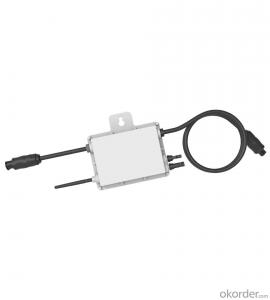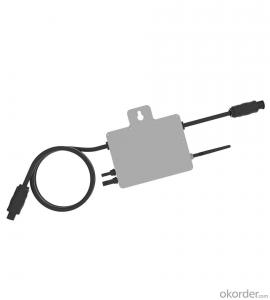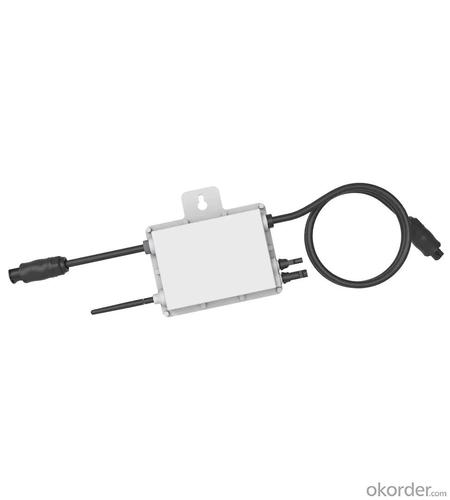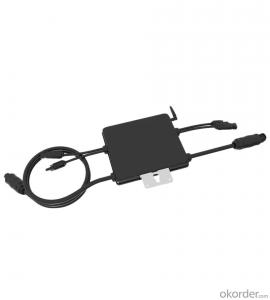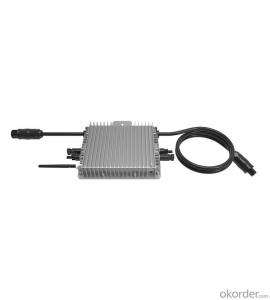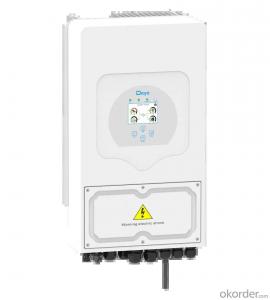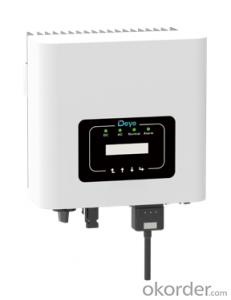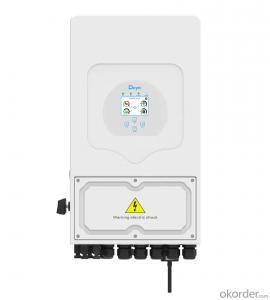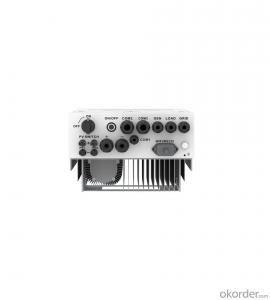All in One Solar Inverter Charger - sun300/500g3-eu-230 | 300-500w | Single Phase | 1 MPPT | Micro-Inverter | Rapid Shutdown
- Loading Port:
- Ningbo
- Payment Terms:
- TT OR LC
- Min Order Qty:
- 100 pc
- Supply Capability:
- 5000 pc/month
OKorder Service Pledge
OKorder Financial Service
You Might Also Like
Specification
| Technical Data | ||||||
| Model | SUN300G3-US-220 | SUN300G3-EU-230 | ||||
| Input Data (DC) | ||||||
| Recommended input Power (STC) | 210~400W (1 Piece) | 210~600W (1 Piece) | ||||
| Maximum input DC Voltage | 60V | |||||
| MPPT Voltage Range | 25~55V | |||||
| Full Load DC Voltage Range (V) | 24.5~55V | 40~55V | ||||
| Max. DC Short Circuit Current | 19.5A | |||||
| Max. input Current | 13A | |||||
| No.of MPP Trackers | 1 | |||||
| No.of Strings per MPP Tracker | 1 | |||||
| Output Data (AC) | ||||||
| Rated output Power | 300W | 500W | ||||
| Rated output Current | 1.4A | 1.3A | 2.3A | 2.2A | ||
| Nominal Voltage / Range (this may vary with grid standards) | 220V/0.85Un-1.1Un | 230V/0.85Un-1.1Un | 220V/0.85Un-1.1Un | 230V/0.85Un-1.1Un | ||
| Nominal Frequency / Range | 50 / 60Hz | |||||
| Extended Frequency / Range | 45~55Hz / 55~65Hz | |||||
| Power Factor | >0.99 | |||||
| Maximum units per branch | 17 | 10 | ||||
| Efficiency | ||||||
| CEC Weighted Efficiency | 95% | |||||
| Peak Inverter Efficiency | 96.5% | |||||
| Static MPPT Efficiency | 99% | |||||
| Night Time Power Consumption | 50mW | |||||
| Mechanical Data | ||||||
| Ambient Temperature Range | -40~65℃ | |||||
| Size (mm) | 189W×184H×31.5D (Without mounting bracket and cable) | |||||
| Weight (kg) | 2.15 | |||||
| Cooling | Natural cooling | |||||
| Enclosure Environmental Rating | IP67 | |||||
| Features | ||||||
| Compatibility | Compatible with 60~72 cell PV modules | |||||
| Communication | Power line / WIFI / Zigbee | |||||
| Grid Connection Standard | EN50549-1, VDE0126-1-1, VDE 4105, ABNT NBR 16149, ABNT NBR 16150, ABNT NBR 62116, RD1699, UNE 206006 IN, UNE 206007-1 IN, IEEE1547 | |||||
| Safety EMC / Standard | UL 1741, IEC62109-1/-2, IEC61000-6-1, IEC61000-6-3, IEC61000-3-2, IEC61000-3-3 | |||||
| Warranty | 10 years | |||||
Module level monitoring, safer and smarter
1 unit for 1 panel, maximize energy from each panel
Rapid shutdown function
IP67 protection degree,10 years warranty
PLC, Zigbee or WIFI communication
1 MPP trackers, module level monitoring
The SUN 300-500G3 is new generation grid-tied microinverter with single MPPT, adapting to connect 1pcs PV module. Thanks to the 1 MPP tracker design, ensuring that each PV module can harvest the highest power generation. Viewable panel performance on a PC, tablet or smart phone
- Q: Can a solar inverter be connected to a battery storage system?
- Yes, a solar inverter can be connected to a battery storage system. This allows excess solar energy generated during the day to be stored in the batteries and used later when there is no sunlight, providing a reliable source of power.
- Q: How is the efficiency of a solar inverter measured?
- The efficiency of a solar inverter is typically measured by calculating the ratio of the output power to the input power. This is done by dividing the AC power output by the DC power input, and then multiplying the result by 100 to obtain a percentage value.
- Q: Can a solar inverter be used with a solar-powered remote monitoring system?
- Yes, a solar inverter can be used with a solar-powered remote monitoring system. The solar inverter is responsible for converting the DC (direct current) electricity generated by the solar panels into AC (alternating current) electricity that can be used to power various devices, including the remote monitoring system. This allows the system to operate efficiently and effectively, ensuring that the solar-powered remote monitoring system functions properly and provides real-time data monitoring.
- Q: What is the maximum number of parallel inverters that can be connected?
- The maximum number of parallel inverters that can be connected depends on various factors such as the power rating, capacity, and design of the inverters, as well as the electrical system they are being connected to. It is best to consult the manufacturer's specifications and guidelines to determine the maximum number of parallel inverters that can be safely connected.
- Q: What is the role of power factor correction in a solar inverter?
- The role of power factor correction in a solar inverter is to improve the efficiency and performance of the inverter by correcting and optimizing the power factor of the electrical system. By adjusting the phase relationship between voltage and current, power factor correction ensures that the inverter draws and supplies power more effectively, reducing energy losses, improving power quality, and minimizing harmonics in the system. This helps to maximize the overall power output and reliability of the solar inverter, leading to better energy conversion and utilization.
- Q: How does a solar inverter handle variations in solar panel cleanliness?
- A solar inverter is not directly responsible for handling variations in solar panel cleanliness. However, a clean solar panel allows for maximum absorption of sunlight, resulting in optimal energy production. If solar panels are dirty, the amount of sunlight absorbed decreases, leading to reduced energy generation. It is the responsibility of the solar panel owner to regularly clean and maintain the panels to ensure their efficiency.
- Q: Can a solar inverter be used with a solar-powered pool heating system?
- Yes, a solar inverter can be used with a solar-powered pool heating system. A solar inverter is responsible for converting the DC (direct current) power generated by solar panels into AC (alternating current) power that can be used by household appliances or fed back into the electrical grid. In the case of a solar-powered pool heating system, the solar panels generate DC power, which is then converted by the inverter into AC power to operate the pool heating system.
- Q: How does a solar inverter handle shade on solar panels?
- A solar inverter handles shade on solar panels by utilizing a technology called maximum power point tracking (MPPT). MPPT allows the inverter to constantly monitor the output of each individual solar panel and adjust the voltage and current to maximize the power production. When shade is detected on a solar panel, the inverter automatically reduces the power output of the affected panel, ensuring that the shaded area does not significantly impact the overall performance of the system.
- Q: How does a solar inverter interact with a battery storage system?
- A solar inverter interacts with a battery storage system by converting the direct current (DC) electricity generated by the solar panels into alternating current (AC) electricity that can be used to power homes and businesses. It also manages the flow of electricity between the solar panels, the battery storage system, and the electrical grid. When the solar panels produce more electricity than is being used, the excess energy is stored in the battery system for later use. Conversely, when the solar panels do not generate enough electricity to meet the demand, the inverter draws power from the battery storage system to supplement the shortfall. This interaction ensures a continuous and reliable power supply from solar energy, even during periods of low sunlight or high energy demands.
- Q: Can a solar inverter be used with a single solar panel?
- Yes, a solar inverter can be used with a single solar panel. The purpose of a solar inverter is to convert the direct current (DC) generated by the solar panel into usable alternating current (AC) electricity. Whether you have one or multiple solar panels, a solar inverter is necessary to convert the DC power into AC power that can be used to power electrical appliances or be fed back into the grid.
Send your message to us
All in One Solar Inverter Charger - sun300/500g3-eu-230 | 300-500w | Single Phase | 1 MPPT | Micro-Inverter | Rapid Shutdown
- Loading Port:
- Ningbo
- Payment Terms:
- TT OR LC
- Min Order Qty:
- 100 pc
- Supply Capability:
- 5000 pc/month
OKorder Service Pledge
OKorder Financial Service
Similar products
Hot products
Hot Searches
Related keywords
